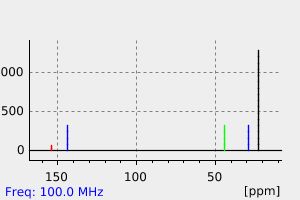2,5-bis(2-methylpropyl)pyrazine | 65032-04-4
中文名称
——
中文别名
——
英文名称
2,5-bis(2-methylpropyl)pyrazine
英文别名
2,5-di-iso-butylpyrazine;2,5-diisobutylpyrazine;2,5-diisobutyl-pyrazine;2,5-Di-isobutylpyrazin;2,5-Di-i-butylpyrazin
CAS
65032-04-4
化学式
C12H20N2
mdl
MFCD18449207
分子量
192.304
InChiKey
WSRPXRPLNPKUCF-UHFFFAOYSA-N
BEILSTEIN
——
EINECS
——
-
物化性质
-
计算性质
-
ADMET
-
安全信息
-
SDS
-
制备方法与用途
-
上下游信息
-
文献信息
-
表征谱图
-
同类化合物
-
相关功能分类
-
相关结构分类
物化性质
-
沸点:95-98 °C(Press: 4 Torr)
-
密度:0.923±0.06 g/cm3(Predicted)
-
保留指数:1387
计算性质
-
辛醇/水分配系数(LogP):3
-
重原子数:14
-
可旋转键数:4
-
环数:1.0
-
sp3杂化的碳原子比例:0.666
-
拓扑面积:25.8
-
氢给体数:0
-
氢受体数:2
上下游信息
-
上游原料
中文名称 英文名称 CAS号 化学式 分子量 —— 2,5-bis(2-methylpropyl)pyrazin-N-oxide 65257-58-1 C12H20N2O 208.304 吡嗪,3-氯-2,5-二(2-甲基丙基)- 3-chloro-2,5-bis(2-methylpropyl)pyrazine 19803-49-7 C12H19ClN2 226.749 —— 2,5-Dichloro-3,6-diisobutylpyrazine 19803-47-5 C12H18Cl2N2 261.194 -
下游产品
中文名称 英文名称 CAS号 化学式 分子量 —— 2,5-bis(2-methylpropyl)pyrazin-N-oxide 65257-58-1 C12H20N2O 208.304 吡嗪,3-氯-2,5-二(2-甲基丙基)- 3-chloro-2,5-bis(2-methylpropyl)pyrazine 19803-49-7 C12H19ClN2 226.749
反应信息
-
作为反应物:描述:2,5-bis(2-methylpropyl)pyrazine 在 sodium metaborate 、 双氧水 、 三氯氧磷 作用下, 以 溶剂黄146 为溶剂, 反应 14.0h, 生成 吡嗪,3-氯-2,5-二(2-甲基丙基)-参考文献:名称:来自鳄鱼粘杆菌和海洋细菌的新型吡嗪摘要:使用 CLSA 或 SPME 顶空方法收集了来自北海的 2 株粘杆菌 Chondromyces crocatus 和 7 株海洋 Alphaproteobacteria 释放的挥发物,并通过 GC-MS 进行分析。在 C. crocatus 的提取物中鉴定出属于不同类别的 27 种吡嗪。2,5-二烷基吡嗪和相关的3-甲氧基-2,5-二烷基吡嗪占主导地位。从天然来源获得了几种吡嗪,如 2-(1-甲基乙烯基)-5-(1-甲基乙基)吡嗪 (7) 和具有甲基、异丙基、异丁基或仲丁基侧链的 3-甲氧基-2,5-二烷基吡嗪首次。鉴定必须依赖合成参考材料,这些参考材料是使用 Furstner 铁催化的氯吡嗪与格氏试剂偶联或叠氮酮缩合获得的关键步骤。合成材料允许鉴定两种以前未知的细菌来源的菠萝甲虫 Carpophilus humeralis 引诱剂,即 3-甲氧基-2-(1-甲基丙基)-5-(2-甲基丙基)吡嗪DOI:10.1002/ejoc.200500280
-
作为产物:描述:1-bromo-4-methyl-2-pentanone 在 sodium azide 、 三苯基膦 作用下, 以 乙醇 、 水 、 溶剂黄146 、 苯 为溶剂, 反应 44.0h, 生成 2,5-bis(2-methylpropyl)pyrazine参考文献:名称:来自鳄鱼粘杆菌和海洋细菌的新型吡嗪摘要:使用 CLSA 或 SPME 顶空方法收集了来自北海的 2 株粘杆菌 Chondromyces crocatus 和 7 株海洋 Alphaproteobacteria 释放的挥发物,并通过 GC-MS 进行分析。在 C. crocatus 的提取物中鉴定出属于不同类别的 27 种吡嗪。2,5-二烷基吡嗪和相关的3-甲氧基-2,5-二烷基吡嗪占主导地位。从天然来源获得了几种吡嗪,如 2-(1-甲基乙烯基)-5-(1-甲基乙基)吡嗪 (7) 和具有甲基、异丙基、异丁基或仲丁基侧链的 3-甲氧基-2,5-二烷基吡嗪首次。鉴定必须依赖合成参考材料,这些参考材料是使用 Furstner 铁催化的氯吡嗪与格氏试剂偶联或叠氮酮缩合获得的关键步骤。合成材料允许鉴定两种以前未知的细菌来源的菠萝甲虫 Carpophilus humeralis 引诱剂,即 3-甲氧基-2-(1-甲基丙基)-5-(2-甲基丙基)吡嗪DOI:10.1002/ejoc.200500280
文献信息
-
Synthesis of Pyrazines and Quinoxalines via Acceptorless Dehydrogenative Coupling Routes Catalyzed by Manganese Pincer Complexes作者:Prosenjit Daw、Amit Kumar、Noel Angel Espinosa-Jalapa、Yael Diskin-Posner、Yehoshoa Ben-David、David MilsteinDOI:10.1021/acscatal.8b02208日期:2018.9.7Base-metal catalyzed dehydrogenative self-coupling of 2-amino alcohols to selectively form functionalized 2,5-substituted pyrazine derivatives is presented. Also, 2-substituted quinoxaline derivatives are synthesized by dehydrogenative coupling of 1,2-diaminobenzene and 1,2-diols. In both cases, water and hydrogen gas are formed as the sole byproducts. The reactions are catalyzed by acridine-based
-
Synthesis of Peptides and Pyrazines from β-Amino Alcohols through Extrusion of H2 Catalyzed by Ruthenium Pincer Complexes: Ligand-Controlled Selectivity作者:Boopathy Gnanaprakasam、Ekambaram Balaraman、Yehoshoa Ben-David、David MilsteinDOI:10.1002/anie.201105876日期:2011.12.16Your choice: The choice of the Ru‐pincer‐complex catalyst determines if peptides or pyrazines are formed from β‐amino alcohols. Use of PNN complex 1 leads to linear poly(alanine) or to cyclic dipeptides, depending on the R group (see scheme). With the PNP complex 2, pyrazines are formed. These reactions are homogeneously catalyzed under neutral conditions and are environmentally benign.
-
Facile and Efficient Deoxygenation of Aromatic N-Oxides with Zinc and Aqueous Ammonium Chloride作者:Yutaka Aoyagi、Tomomitsu Abe、Akihiro OhtaDOI:10.1055/s-1997-1280日期:1997.8Several aromatic N-oxides such as pyrazine, arylpyridine and quinoline N-oxides have been deoxygenated to parent amines under mild and efficient conditions using zinc and aqueous ammonium chloride in tetrahydrofuran.
-
USE OF RUTHENIUM COMPLEXES FOR FORMATION AND/OR HYDROGENATION OF AMIDES AND RELATED CARBOXYLIC ACID DERIVATIVES申请人:Milstein David公开号:US20120253042A1公开(公告)日:2012-10-04A process for preparing amides by reacting a primary amine and a primary alcohol in the presence of a Ruthenium complex to generate the amide and molecular hydrogen. Primary amines are directly acylated by equimolar amounts of alcohols to produce amides and molecular hydrogen (the only byproduct) in high yields and high turnover numbers. Also disclosed are processes for hydrogenation of amides to alcohols and amines; hydrogenation of organic carbonates to alcohols; hydrogenation of carbamates or urea derivatives to alcohols and amines; amidation of esters; acylation of alcohols using esters; coupling of alcohols with water and a base to form carboxylic acids; dehydrogenation of beta-amino alcohols to form pyrazines and cyclic dipeptides; and dehydrogenation of secondary alcohols to ketones. These reactions are catalyzed by a Ruthenium complex which is based on a dearomatized PNN-type ligand of formula A1 or precursors thereof of formulae A2 or A3.
-
NOVEL RUTHENIUM COMPLEXES AND THEIR USES IN PROCESSES FOR FORMATION AND/OR HYDROGENATION OF ESTERS, AMIDES AND DERIVATIVES THEREOF申请人:Milstein David公开号:US20130281664A1公开(公告)日:2013-10-24The present invention relates to novel Ruthenium catalysts and related borohydride complexes, and the use of such catalysts, inter alia, for (1) hydrogenation of amides (including polyamides) to alcohols and amines; (2) preparing amides from alcohols with amines (including the preparation of polyamides (e.g., polypeptides) by reacting dialcohols and diamines and/or by polymerization of amino alcohols); (3) hydrogenation of esters to alcohols (including hydrogenation of cyclic esters (lactones) or cyclic di-esters (di-lactones) or polyesters); (4) hydrogenation of organic carbonates (including polycarbonates) to alcohols and hydrogenation of carbamates (including polycarbamates) or urea derivatives to alcohols and amines; (5) dehydrogenative coupling of alcohols to esters; (6) hydrogenation of secondary alcohols to ketones; (7) amidation of esters (i.e., synthesis of amides from esters and amines); (8) acylation of alcohols using esters; (9) coupling of alcohols with water to form carboxylic acids; and (10) dehydrogenation of beta-amino alcohols to form pyrazines. The present invention further relates to the novel uses of certain pyridine Ruthenium catalysts.
表征谱图
-
氢谱1HNMR
-
质谱MS
-
碳谱13CNMR
-
红外IR
-
拉曼Raman
-
峰位数据
-
峰位匹配
-
表征信息
同类化合物
(S)-3-(2-(二氟甲基)吡啶-4-基)-7-氟-3-(3-(嘧啶-5-基)苯基)-3H-异吲哚-1-胺
(6-羟基嘧啶-4-基)乙酸
(4,5-二甲氧基-1,2,3,6-四氢哒嗪)
鲁匹替丁
马西替坦杂质7
马西替坦杂质4
马西替坦杂质
马西替坦原料药杂质D
马西替坦原料药杂质B
马西替坦
顺式-4-{[5-溴-2-(2,5-二甲基-1H-吡咯-1-基)-6-甲基嘧啶-4-基]氨基}环己醇
非沙比妥
非巴氨酯
非尼啶醇
青鲜素钾盐
雷特格韦钾盐
雷特格韦相关化合物E(USP)
雷特格韦杂质8
雷特格韦EP杂质H
雷特格韦-RT9
雷特格韦
阿西莫司杂质3
阿西莫司
阿脲四水合物
阿脲一水合物
阿维霉素
阿米美啶
阿米洛利
阿米妥钠
阿洛巴比妥
阿普瑞西他滨
阿普比妥
阿巴卡韦相关化合物B(USP)
阿卡明
阿伐那非杂质V
阿伐那非杂质1
阿伐那非杂质
阿伐那非中间体
阿伐那非
铂(2+)二氯化6-甲基-1,3-二{2-[(2-甲基丙基)硫烷基]乙基}嘧啶-2,4(1H,3H)-二酮(1:1)
钴1,2,3,6-四氢-2,6-二氧代嘧啶-4-羧酸酯(1:2)
钠5-烯丙基-4,6-二氧代-1,4,5,6-四氢-2-嘧啶醇酸酯
钠5-乙基-4,6-二氧代-1,4,5,6-四氢-2-嘧啶醇酸酯
钠5-(2-溴丙-2-烯基)-5-丁烷-2-基-4,6-二氧代-1H-嘧啶-2-醇
醌肟腙
酒石酸噻吩嘧啶
那可比妥
辛基2,6-二氧代-1,2,3,6-四氢-4-嘧啶羧酸酯
赛乐西帕杂质3
赛乐西帕KSM3







